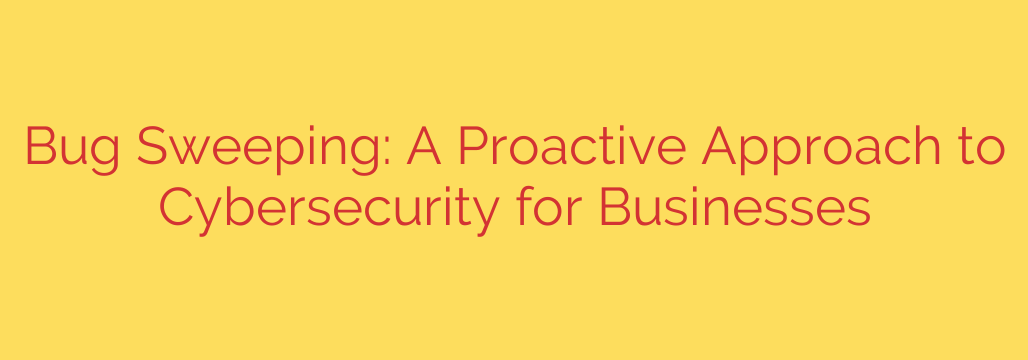
Protecting Your Corporate Secrets: A Guide to Bug Sweeping and TSCM
In the high-stakes world of business, information is your most valuable asset. Confidential client lists, proprietary product designs, and sensitive merger negotiations are the lifeblood of your company. But in an age of miniature, sophisticated surveillance technology, how can you be sure your private conversations are actually staying private? The threat of corporate espionage is real, and it often begins with a tiny, hidden device.
This is where bug sweeping, known professionally as Technical Surveillance Countermeasures (TSCM), becomes an essential layer of your cybersecurity strategy. It’s a proactive defense designed to detect and neutralize hidden surveillance threats before they can cause catastrophic damage.
What Exactly Is a Bug Sweep?
A professional bug sweep is far more than a quick look under the boardroom table. It is a meticulous, systematic inspection of a physical space—like an office, home, or vehicle—to detect illicit eavesdropping devices.
These threats can include:
- Hidden microphones and audio recorders
- Covert video cameras (wired and wireless)
- GPS trackers on company vehicles
- Compromised phone lines or network hardware
A TSCM audit is not just a physical search; it involves using sophisticated electronic equipment to scan for radio frequency (RF) transmissions, analyze wiring, and inspect digital networks for vulnerabilities. It is a comprehensive security audit of your physical environment.
Why Bug Sweeping is Critical for Modern Businesses
Investing in a professional bug sweep isn’t about paranoia; it’s about responsible risk management. A single leak of sensitive information can have devastating consequences.
Here’s why TSCM is a non-negotiable for security-conscious organizations:
- Protecting Intellectual Property: Your trade secrets, research and development data, and strategic plans are prime targets for competitors. A hidden bug can leak years of hard work in an instant.
- Safeguarding Financial Negotiations: During mergers, acquisitions, or major funding rounds, confidentiality is paramount. A leak could derail the entire deal or severely weaken your negotiating position.
- Ensuring Executive Privacy: C-suite executives are high-value targets. Sweeps of their offices, homes, and vehicles protect both personal privacy and corporate security, preventing blackmail or the leakage of sensitive “off-the-record” conversations.
- Maintaining Client and Legal Confidentiality: For law firms, financial institutions, and healthcare providers, client confidentiality is a legal and ethical obligation. A breach not only damages trust but can also lead to severe legal penalties.
- Preventing Reputational Damage: Imagine a private, critical conversation about a product flaw or internal crisis being leaked to the media. The reputational fallout can be immediate and long-lasting.
Key Triggers: When to Conduct a Professional Sweep
While regular sweeps are a best practice, certain events should trigger an immediate TSCM audit.
Consider scheduling a sweep if you experience:
- Sudden Information Leaks: If competitors seem to know your moves in advance or private information appears in public, it’s a major red flag.
- Before or After Critical Meetings: Secure the boardroom before and after M&A discussions, strategic planning sessions, or major legal depositions.
- Personnel Changes: A disgruntled former employee, especially at the executive or IT level, poses a significant threat. They have the knowledge and potential motive to plant a device.
- Moving into a New Office: You have no idea what the previous tenants may have left behind. Starting with a clean, verified environment is a crucial first step.
- Unusual Occurrences: If you notice strange sounds on your phone lines, unexpected static, or small, unexplained debris near walls or outlets, trust your instincts and call in an expert.
The TSCM Process: What to Expect
A professional TSCM team operates with discretion and precision. The process typically involves several phases:
- Confidential Consultation: Experts will discuss your specific concerns, potential threats, and the areas to be inspected.
- Physical Inspection: A meticulous, hands-on search for devices. This includes checking furniture, ceilings, electronics, outlets, and decor for any signs of tampering.
- Electronic Analysis: Specialists use equipment like spectrum analyzers and non-linear junction detectors to identify active electronic transmissions and locate hidden electronics—even if they are turned off.
- Network and Telecom Audit: Your phone systems, Wi-Fi networks, and computer hardware are inspected for unauthorized monitoring hardware or software vulnerabilities.
- Comprehensive Reporting: After the sweep, you receive a detailed report outlining the findings, any vulnerabilities discovered, and actionable recommendations for improving your overall security posture.
A Final Word: Don’t Rely on DIY Solutions
While inexpensive bug detectors are available online, they are no match for professional-grade surveillance devices. These consumer gadgets often create a false sense of security, as they can easily miss passive (non-transmitting) bugs, encrypted signals, or professionally installed devices.
When it comes to corporate security, the expertise, advanced equipment, and proven methodology of a professional TSCM team are indispensable. In the fight against corporate espionage, a proactive approach isn’t just wise—it’s essential for survival. Don’t wait for a breach to expose your vulnerabilities. Take control of your environment and secure your company’s future.
Source: https://collabnix.com/how-bug-sweeping-can-help-businesses-stay-ahead-of-cyber-threats/








